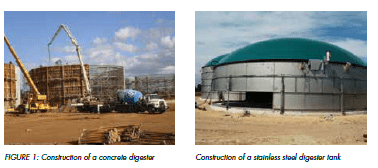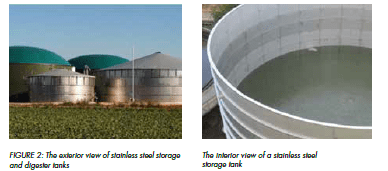Energy production from biomass and waste will nearly double between 2009 and 2035, according to the International Energy Agency, opening the way for massive growth in the production of biogas plants.
 The process whereby waste is converted to energy at high temperature creates a highly hostile environment.
The process whereby waste is converted to energy at high temperature creates a highly hostile environment.
During the digestion stage, bacteria transform the organic material into biogas in three steps:
- Acidogenic bacteria break the waste down into simpler molecules. Ammonia, CO2 and hydrogen sulphide (H2S) are by-products of this step.
- Acetogenic bacteria digest the simple molecules to produce CO2, H2, and CH3COOH.
- Methanogens act on the acetic acid to produce biogas. The biogas is a mixture of CH4 (55-70%), CO2 (20-40%), H20 vapour and some residual (often corrosive) gases.
Digestion is optimised by keeping the temperature at about 40°C and the pH level between 5.5 and 8.5. The system can be self-powered by the exothermic digestion process, though usually additional heat is provided by burning some of the biogas.
Sometimes substances in the inlet and/or outlet areas must be heat treated so that germs and bacteria are rendered harmless and do not spread. Two different methods of heat treatment are used:
- Hygienisation: the material is heated to 70°C and held at that temperature for 60 minutes.
- Pasteurisation: the material is heated to 133°C (271.4°F) and held at that temperature for 20 minutes.
These high temperature treatments create a hostile environment. Stainless steel is among the few materials that can withstand the aggressive gases produced.
 STAINLESS STEEL IN A BIOGAS PLANT
STAINLESS STEEL IN A BIOGAS PLANT
Corrosive compounds such as H2S and NH3 are unavoidable by-products of the biogas production process. All equipment in the digester tanks comes into contact with these corrosive elements. Unless corrosion-resistant materials are used, damage to equipment will occur.
It is essential to avoid breakdowns, as restarting a digester is a long and delicate operation.
Properly specified stainless steel can withstand corrosive environments in a biogas plant. This is why stainless steel is typically utilised in:
- Digesters
- Pumps and valves
- Agitators
- Pipes and fittings
- Purification applications.
STAINLESS STEEL IN DIGESTERS
Concrete is currently the most widely used material to build digesters because of its cost advantages and flexibility.
However, construction must be relatively large scale to be cost effective and requires several heavy machines. Construction of concrete digesters in typical biogas plant is shown in Figure 1.

During operation, regular maintenance is very important to prevent leakages. Leakages of gas, water and odour from a digester can cause serious problems for the plant. It is hard to avoid corrosion in concrete digester tanks, even though a special coating system is utilised.
These problems can be avoided if a stainless steel tank is used. The thickness of stainless steel plate for a biogas tank is less than 5 mm and it is very easy to construct.
Stainless steel biogas tanks are assembled from top to bottom and lifted into place using a simple system.
Stainless steel has many advantages in this application including:
- Lower construction and logistic costs: a typical tank can be completed within a week.
- Minimal logistics: makes it possible to construct a biogas plant in almost any area.
- No need for repairs thanks to the corrosion resistance of stainless steel. It has excellent corrosion resistance against H2S or NH3.
- Gas and water tightness: joints are easy to keep watertight; holes are easy to drill; and gas leakage is prevented.
- Residual value: at the end of its useful life, the stainless steel has a scrap value.
As well as being used to make the digester, the manure, water and residue storage tanks also utilise stainless steel. Digester tanks are often covered by insulation, as shown in Figure 2.

PUMPS AND VALVES
As is stainless used for pumps and valves handle slurries, fluids and gases which contain corrosive materials.
AGITATORS
Agitators help to homogenise the temperature of the biomass and reduce crust formation. They are in constant contact with corrosive elements.
PIPES AND FITTINGS
Stainless steel is utilised for pipes and fittings in biogas plants for its corrosion resistance and excellent formability. Its heat transfer coefficient is also better than that of plastics. Grade EN 1.4404/AISI 316L is preferred for these applications.
PURIFICATION
The biogas produced by the system contains many impurities (usually H2S) and water vapour, both of which are undesirable. H2S (or Hydrogen sulfide) is poisonous and smells of rotten eggs, while water vapour reduces the efficiency of biogas when it is burnt to generate electricity. A biogas dehumidifier provides efficient dehumidification and is easy to install and maintain.
In most cases, the dehumidification process takes place before the H2S is removed. Stainless steel (grade EN 1.4404/AISI 316L) is often used for the parts of dehumidifier systems which come into contact with wet biogas as it can withstand the corrosive effects of the H2S it contains.
CONCLUSION
Stainless steel improves the reliability and efficiency of biogas plants, which is in itself a very competitive and successful source of renewable energy. Its performance has already been demonstrated, making it the material of choice for biogas processing equipment.



